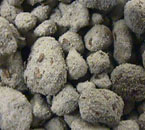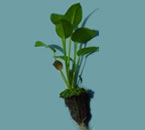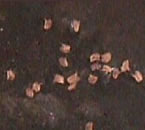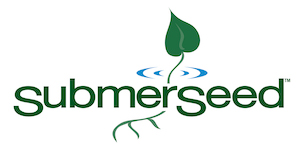Versatile, Cost-Effective Alternative
Traditionally, restoration wetland vegetation is introduced (or re-introduced) into an aquatic environment using two basic methods: plug planting and seeding. The SubmerSeed® Composite Seeding Technology was developed by AquaBlok, Ltd. to address the limitations of these established propagation methods.
SubmerSeed particles serve as reliable vectors, delivering discrete packets of valuable seed to the location where they are intended to germinate and grow. The result: thriving colonies of color, beauty, and valuable habitat.
Product Description
SubmerSeed is a composite-aggregate material made up of a dense aggregate core and viable wetland or aquatic seeds held in place with clay or clay-sized material and organic polymers. The technology provides an alternative to traditional means of plant propagation in wetland/aquatic settings, especially when faced with the challenges of establishing a favorable vegetative community in or near inundated conditions. The typical formulation of dry product relies on the nutrients available in the surrounding water and underlying sediment to support germination and nourish sustained growth. In addition, nutrient-amended product formulations can be provided.
Close-up of typical SubmerSeed particles (approximate size: ¼” – ½”)
Product Use
SubmerSeed use generally involves broadcasting dry masses of the product through water across the surface of the sediment or wetland area. Product coverage rates will vary depending on the species composition and the site-specific requirements for the project.
Although variable, a rate of 1,500 to 2,500 pounds of dry product per acre (approximately 20 to 30 cubic feet dry product per acre) is a reasonable approximation of the quantity of material needed for a typical application. For smaller scale projects, this broad coverage range equates to an application rate of one pound of SubmerSeed for every 18 - 25 square feet to be sown with product.
SubmerSeed vs Traditional Methods
SubmerSeed can outperform vegetative plug installation (the planting of seedlings, cuttings, or other established plant materials) through cost savings in both materials and labor.
SubmerSeed composite technology has advantages over traditional seeding (e.g. broadcasting, drilling, hydro-seeding, etc.) in circumstances where accuracy and sustained seed placement are integral to the success of the project.
The reliability of SubmerSeed reduces the risk of seed loss (waste) by wave action, currents, or tidal forces, even when the seeds (often buoyant by nature) are in direct contact with water. Unlike traditional seeding methods, SubmerSeed is appropriate for seed introduction in inundated or flood-prone environments (provided the species selected is well-adapted for germination and growth under such conditions).
The combination of a lower per-unit plant cost along with considerably less labor-intensive installation requirements and increased viability of seed germination can make SubmerSeed an attractive alternative.
The competitive advantage of the technology is particularly striking when pricing large-scale (i.e., > 1 acre) installation projects. Additionally (and contrary to plug installation), SubmerSeed readily allows for both the introduction of a single species or a suite of desired species without significant additional labor.
Primary Settings for SubmerSeed Applications
General wetland enhancement, restoration & construction sites
Mitigation wetlands
Farm pond & borrow area shoreline and littoral shelves
Stream bank stabilization projects
Habitat reclamation areas
Invasive species eradication areas
Wastewater facilities (phytoremediation)
Sediment dewatering projects (combined disposal facilities)
Aquaculture facilities
Golf course waterways
Native nurseries
Hunting/Fishing clubs
Commercial and residential landscapes & water garden
Application Methods
SubmerSeed typically involves broadcasting dry masses of product through water and across the surface of the underlying sediment (or sediment cap, if lined with AquaBlok®) or wetland area. SubmerSeed can be applied using commonly available equipment (e.g. hand-held broadcasters, tow-behind spreaders, seed slings, etc.) and, especially in smaller-scale installations, can simply be dispersed by hand. Even when access is limited, seeding can be completed from the air.
Aerial
Conveyor
Hand
Spinner
Species Selection
To date, the focus has been primarily on plant species included in the emergent community of freshwater habitats. As their name implies, these are species that grow through shallow water, emerging from the surface to help bridge the gap between land and water.
These plants are at home in marshes, riverside wetlands, streambanks, floodplains, and the shorelines and shallows of ponds and lakes. Thus far, species have been selected based on their ability to satisfy most, if not all, of the following criteria:
Known seed producer
Manageable seed morphology (able to be incorporated into product)
Readily available and reasonably affordable
Durable/hardy but NOT overly aggressive*
Tolerant of a broad range of growing conditions
Potential candidate for phytoremediation
Valuable to wildlife
Wide geographical distribution*
Aesthetically pleasing as a mature plant
*Care is taken to match the geographic location of an application site with the native area in which the plant species would naturally flourish. In other words, species incorporated into the SubmerSeed technology are intended to be native to the region to where the product is to be applied, and attention is given to match a potential site with appropriate plant species. Care is taken not to introduce invasive or overly aggressive species that can crowd out and dominate native vegetation, unless monocultures are preferred.
For a list of additional species that could be appropriate for incorporation into the SubmerSeed technology, please visit ErnstSeed.com. An extensive array of obligate (OBL) and facultative (FACW) wetland species are available through Ernst Conservation Seeds, many of which can be incorporated into SubmerSeed. AquaBlok, Ltd will also incorporate seed provided by others upon request. If you are considering the establishment of a specific species (emergent, submerged, or otherwise) and want to explore SubmerSeed as an alternative, please complete the form below.






